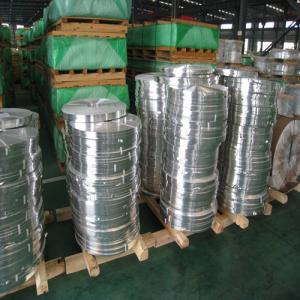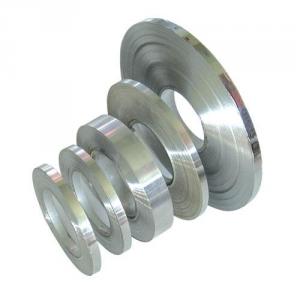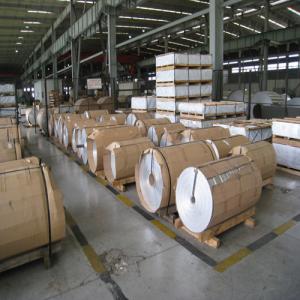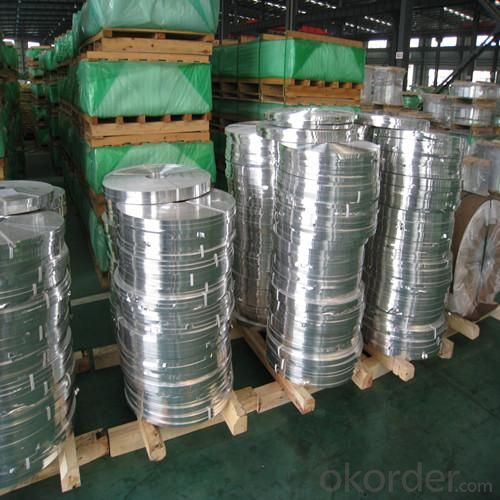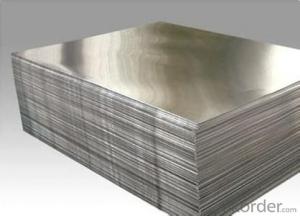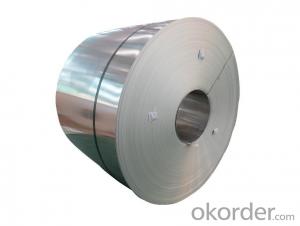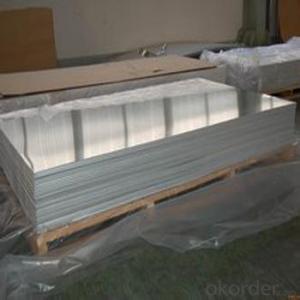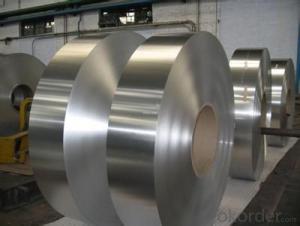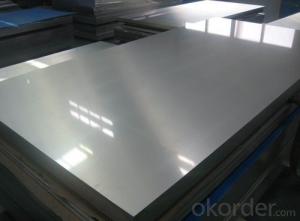Mill Finished Aluminum Strips - Aluminum Sheets in Hawaii
- Loading Port:
- China Main Port
- Payment Terms:
- TT or L/C
- Min Order Qty:
- 2 Tons m.t.
- Supply Capability:
- 6000 Tons Per Month m.t./month
OKorder Service Pledge
OKorder Financial Service
You Might Also Like
1. Specifications and Application of Mill Finished Aluminium Strips
Application | Alloy Type | Temper | Thickness(mm) | Width(mm) |
For Curtain wall | 1050,1100,3003,5050 | H14,H24 | 2.0~4.0 | 700~2000 |
For aluminum composite panel | 1100,3003, | H18 | 0.2~0.8 | 10S00~1500 |
For frame | 5052 | H32 | 0.5~2.0 | 500~1500 |
Bottle lids stock | 8011 | H14,H16,H22 | 0.17~0.22 | 500~900 |
PS base sheet | 1060 | H18 | 0.14/0.27 | 700~1500 |
Hot rolled and continuous cast stock | 1xxx,3xxx,5xxx,8xxx | O,F,H | 3.0~10.0 | 1000~1500 |
Heavy Thickness plate | 6061,5052,5083,5754 | H111,H112,H38,F | 10~120 | 600~1200 |
other Commons sheets | 1xxx,3xxx,5xxx,8xxx | O,H1x,H2x | 0.2~10 | 500~1500 |
For capacitor shell | 1100 | O,HX2,HX4 | 0.2~0.5 | 300~1200 |
For aluminum plastic composite pipe | 1050,1060,1100,1200,8011 | O,H22 | 0.2~1.5 | 30~300 |
Embossed aluminum sheet | 1050,1060,3003,1100,3105 | H14,H24 | 0.8~3.0 | 1000~1500 |
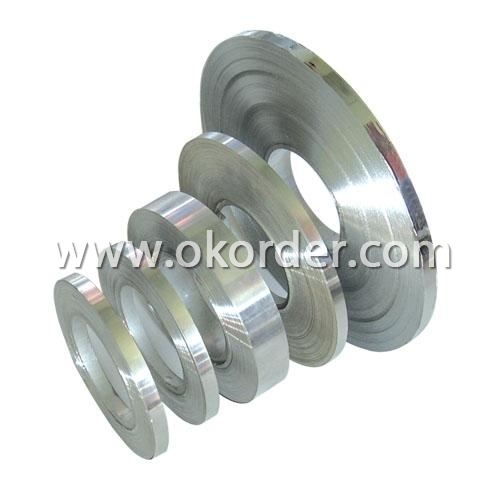
2. Packaging & Delivery of Mill Finished Aluminium Strips
Packaging: Seaworth package, water-proof paper wrapped inside, carton wrapped outside in wooden pallets.
Shipment: The goods will be delivered in not more than 40 days after getting the buyer's payment.
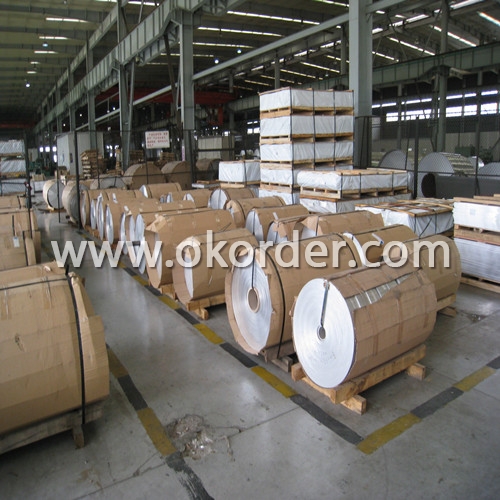
3. Production Flow of Diamond Embossed Coated Aluminium Coil
Melting-Rolling- Cutting- Annealing--Packing
- Q: 1 ton of aluminium=______ tons of Alumina
- three tons
- Q: Can aluminum sheets be used in food packaging?
- Indeed, aluminum sheets find widespread application in the realm of food packaging. The utilization of aluminum in this context is prevalent owing to its exceptional capability to shield food from detrimental elements like light, oxygen, moisture, and other external agents that may cause spoilage or contamination. Notably, aluminum sheets possess the qualities of being lightweight, long-lasting, and resistant to corrosion, rendering them perfectly suitable for an array of food packaging formats, including foil wraps, containers, trays, and pouches. Moreover, the recyclability of aluminum further solidifies its status as an eco-friendly option for food packaging.
- Q: What are the surface treatment requirements for aluminum sheets in the food industry?
- In the food industry, aluminum sheets used for food packaging and handling must undergo specific surface treatments to meet hygiene and safety standards. The surface treatment requirements for aluminum sheets in the food industry typically involve processes like cleaning, degreasing, and anodizing. These treatments remove any dirt, oils, or contaminants, and create a protective layer on the aluminum surface to prevent corrosion and ensure the sheets are safe for food contact. Additionally, the surface treatments may also include specific coatings or laminations to enhance the barrier properties and maintain the quality and freshness of the food products.
- Q: Can aluminum sheets be plasma cut?
- Indeed, aluminum sheets are able to undergo plasma cutting. The technique of plasma cutting presents itself as a versatile and highly effective method capable of cutting various materials, including aluminum, with great efficiency. By utilizing a high-speed stream of ionized gas, commonly referred to as plasma, the aluminum sheet can be meticulously shaped and tailored to meet specific requirements. Plasma cutting boasts a multitude of advantages, such as faster cutting speeds, more precise cuts, and significantly reduced heat-affected zones, in contrast to traditional cutting methods. As a result, it has become a widely utilized technique in numerous industries, including automotive, aerospace, and construction, for the purpose of cutting aluminum sheets of varying thicknesses.
- Q: I have a specific design I'd like to cut out of thin sheet metal (aluminum or tin) and I'm wondering how to make it more sturdy. The sheet metal is a bit flimsy. Can I strengthen it by heating it up (butane torch) and cooling it quickly?
- This Site Might Help You. RE: Can you temper aluminum or tin? I have a specific design I'd like to cut out of thin sheet metal (aluminum or tin) and I'm wondering how to make it more sturdy. The sheet metal is a bit flimsy. Can I strengthen it by heating it up (butane torch) and cooling it quickly?
- Q: Can aluminum sheet be painted or coated after fabrication?
- Indeed, it is possible to paint or coat aluminum sheet after it has been fabricated. Aluminum, being a versatile material, lends itself easily to being painted or coated in order to improve its appearance or provide extra protection. The procedure involves preparing the surface through thorough cleaning and the elimination of any impurities, followed by the application of a primer to enhance adhesion. Once the primer has dried, a topcoat of paint or coating can be applied to achieve the desired color or finish. The choice of paint or coating will depend on the intended usage and the specific requirements of the application. All in all, painting or coating aluminum sheet after fabrication is a widespread practice that can significantly enhance its aesthetics and durability.
- Q: What are the different heat treatment options available for aluminum sheets?
- There are several heat treatment options available for aluminum sheets, each offering different properties and characteristics to the material. 1. Annealing: This process involves heating the aluminum sheet to a specific temperature and then slowly cooling it down. Annealing helps to relieve internal stresses in the material and improve its ductility and machinability. 2. Solution Heat Treatment: This treatment involves heating the aluminum sheet to a high temperature and then rapidly quenching it in water or other cooling media. Solution heat treatment is commonly used to dissolve and homogenize any alloying elements present in the aluminum, resulting in improved strength and hardness. 3. Precipitation Hardening: Also known as age hardening, this treatment is typically performed after solution heat treatment. It involves heating the aluminum sheet at a lower temperature for a specific period, allowing the alloying elements to precipitate and form fine particles. This process increases the strength and hardness of the aluminum without sacrificing its ductility. 4. Stress Relieving: This treatment is performed to relieve residual stresses that may have developed during fabrication or machining processes. The aluminum sheet is heated to a specific temperature and then slowly cooled down, reducing the risk of distortion or cracking. 5. Hardening: By heating the aluminum sheet to a specific temperature and then rapidly quenching it, hardening can be achieved. This process increases the strength and hardness of the material, making it more suitable for applications that require high strength-to-weight ratios. It is important to note that the specific heat treatment option chosen for aluminum sheets depends on the desired properties and application requirements. Consulting with a metallurgical expert or referring to the material's specifications can help determine the most suitable heat treatment option.
- Q: What are the electrical conductivity properties of aluminum sheets?
- Aluminum sheets possess excellent electrical conductivity properties. Due to its low electrical resistance, aluminum is widely used in various electrical applications. It has a high conductivity rating, only slightly lower than that of copper, making it an effective conductor of electricity. This property allows aluminum sheets to efficiently transmit electrical current with minimal energy loss. As a result, aluminum is commonly utilized in power transmission lines, electrical wiring, and electrical connectors. Furthermore, aluminum's conductivity makes it suitable for applications that require heat dissipation, such as heat sinks in electronic devices. Overall, aluminum sheets are known for their favorable electrical conductivity, making them a preferred choice in numerous electrical and electronic applications.
- Q: How do I join aluminum sheets together?
- One common method to join aluminum sheets together is through welding. Aluminum can be welded using various techniques such as Tungsten Inert Gas (TIG) welding or Metal Inert Gas (MIG) welding. These methods involve melting the edges of the aluminum sheets and fusing them together using a filler material. Another option is using adhesives specifically designed for aluminum bonding. These adhesives create a strong bond between the sheets when applied correctly. Additionally, mechanical fastening methods like riveting or bolting can also be used to join aluminum sheets together. The appropriate method depends on factors such as the specific application, desired strength, and aesthetic requirements.
- Q: Can aluminum sheets be bent or formed?
- Indeed, it is possible to bend or shape aluminum sheets. Aluminum, being a remarkably malleable and ductile metal, can be effortlessly molded or bent without fracturing. This attribute renders it a favored option for a wide range of purposes, including the production of automotive components, aircraft structures, and household products. Diverse techniques, such as press braking, roll bending, and stretch forming, can be employed to bend or shape aluminum sheets. By utilizing these methodologies, the aluminum sheets can be formed into diverse angles or curves to fulfill precise design prerequisites.
1. Manufacturer Overview
| Location | Henan, China |
| Year Established | 1996 |
| Annual Output Value | Above US$200 Million |
| Main Markets | Mid East;Eastern Europe;North America |
| Company Certifications | ISO 9001:2000;ISO 14001:2004;OHSAS 18001 |
2. Manufacturer Certificates
| a) Certification Name | |
| Range | |
| Reference | |
| Validity Period |
3. Manufacturer Capability
| a) Trade Capacity | |
| Nearest Port | Shanghai |
| Export Percentage | 30%-50% |
| No.of Employees in Trade Department | 21-50 People |
| Language Spoken: | English;Chinese |
| b) Factory Information | |
| Factory Size: | Above 100,000 square meters |
| No. of Production Lines | Above 10 |
| Contract Manufacturing | OEM Service Offered;Design Service Offered |
| Product Price Range | Average |
Send your message to us
Mill Finished Aluminum Strips - Aluminum Sheets in Hawaii
- Loading Port:
- China Main Port
- Payment Terms:
- TT or L/C
- Min Order Qty:
- 2 Tons m.t.
- Supply Capability:
- 6000 Tons Per Month m.t./month
OKorder Service Pledge
OKorder Financial Service
Similar products
Hot products
Hot Searches
Related keywords
